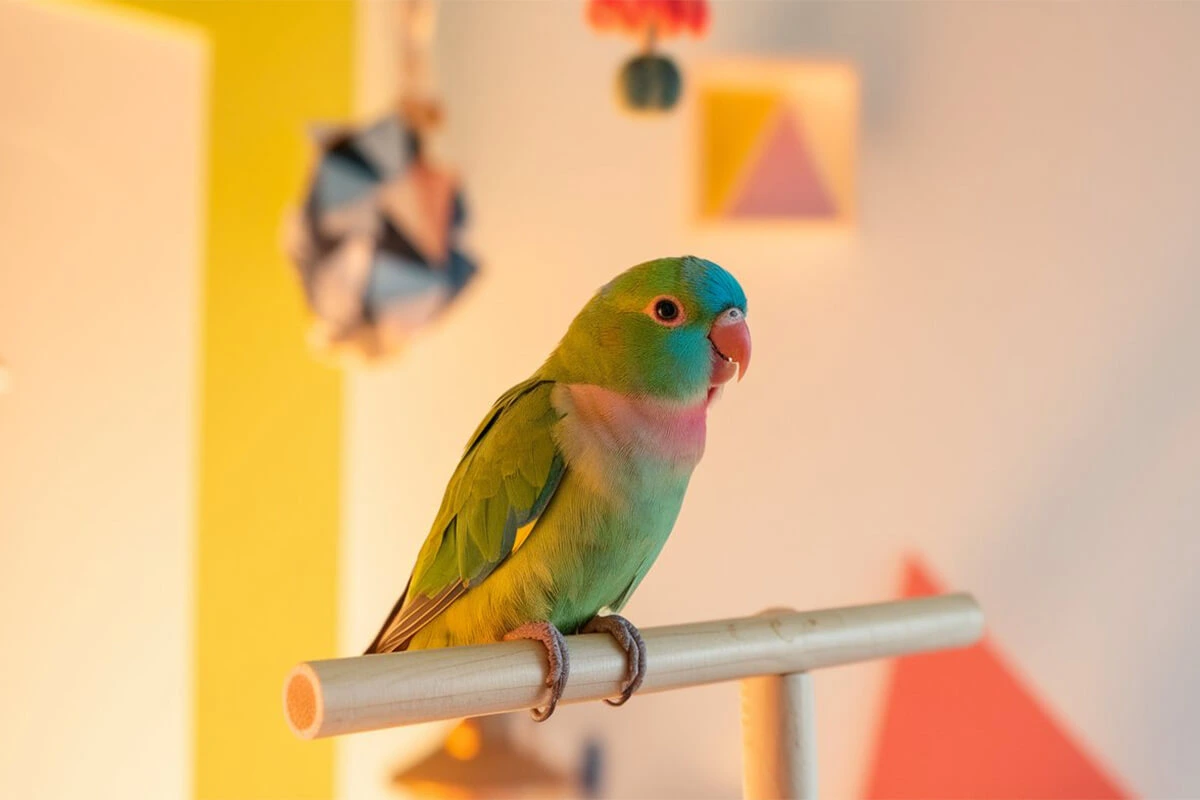Parrotlet types come in a variety of vibrant colors and charming personalities, making them one of the most lovable tiny parrot species. These miniature parrots, often called “pocket parrots,” captivate bird enthusiasts with their playful nature, intelligence, and strong bond with their owners. Despite their small size, parrotlets have bold attitudes and can be just as entertaining and affectionate as larger parrot species.
If you’re considering adding a parrotlet to your family, understanding the different types of parrotlets is essential. Each species has unique characteristics, colors, and temperaments that make them special. In this guide, you’ll discover 10 beautiful parrotlet species, learn about their colors, and find out which ones make the best pets. Whether you’re looking for a talkative companion, a cuddly pet, or a low-maintenance small bird, there’s a perfect parrotlet for you!
What Are Parrotlets? A Quick Overview
Parrotlets as a Group of Small Parrots
Parrotlets are one of the smallest parrot species, belonging to the Forpus genus. These tiny birds originate from Central and South America, where they inhabit forests, grasslands, and tropical regions. Despite their small size, parrotlets have all the traits of larger parrots, including intelligence, curiosity, and strong social bonds.
Parrotlet types vary in color, personality, and temperament. Some, like the Pacific Parrotlet, are more common as pets, while others, such as the Mexican Parrotlet, are less frequently seen in homes. Each species has unique characteristics, but all parrotlets share a lively, independent nature.
Parrotlets thrive on interaction and mental stimulation. They love to explore, climb, and play with toys. While they don’t require as much space as larger parrots, they still need daily out-of-cage time to stay happy and active. With proper care and attention, parrotlets can become affectionate and engaging companions.
Why Are Parrotlets Called “Pocket Parrots”?
People call parrotlets “pocket parrots” because of their incredibly small size and affectionate behavior. Most parrotlet types measure only 4.5 to 5.5 inches, making them even smaller than budgies. Their compact bodies allow them to perch comfortably on a finger, shoulder, or even tuck themselves into a shirt pocket or sleeve.
Despite their size, parrotlets have bold and fearless personalities. They often behave as if they are much larger, displaying confidence and curiosity in every movement. Many parrotlets bond closely with their owners and love snuggling, making them ideal for those who want an affectionate pet.
Parrotlets also tend to form strong, one-on-one relationships. Unlike some small birds that prefer socializing in groups, parrotlets often attach themselves to a single person. They seek attention, enjoy being handled, and may become jealous if ignored. Their affectionate yet sassy nature makes them unique among tiny parrot species.
General Characteristics and Temperament of Parrotlets
Parrotlets are small birds, but they have very strong and fun personalities. These birds are playful, energetic, and highly intelligent. They love exploring, climbing, and interacting with their owners. Because of their curiosity, they need a variety of toys and mental stimulation to prevent boredom.
Parrotlets are independent but also social. Unlike budgies, which prefer flock interaction, parrotlets often form deep bonds with their human caregivers. They crave attention but can become territorial if not properly socialized. Consistent handling helps them remain affectionate and well-behaved.
Although parrotlets are not as loud as larger parrots, they are still vocal. They chirp, whistle, and sometimes mimic words, though their speech abilities are limited compared to larger parrot species. Their voices are soft, making them suitable for apartment living.
Parrotlets are known for their confidence and fearlessness. They often challenge much larger birds or objects, which can be entertaining but also risky. Owners should supervise their interactions with other pets to prevent accidents.
With the right care, parrotlets become affectionate, playful, and entertaining companions. They thrive in homes where they receive daily interaction, training, and enrichment.
10 Different Types of Parrotlets You’ll Love
1. Pacific Parrotlet (Forpus coelestis)
The Pacific Parrotlet is the most common type of pet parrotlet. It is native to Ecuador and Peru and is known for its playful, intelligent, and affectionate nature. These birds are highly social and form strong bonds with their owners, often following them around or perching on their shoulders.
Pacific Parrotlets come in various color mutations, including blue, yellow, albino, and pied. They are easy to train and can learn simple tricks, making them a great choice for first-time bird owners. However, they can be territorial and need proper socialization to prevent aggressive behavior. Their energetic and bold personalities make them one of the most entertaining parrotlet types.
2. Green-Rumped Parrotlet (Forpus passerinus)
The Green-Rumped Parrotlet is the smallest of all parrotlet types, measuring about 4.5 inches in length. Native to Venezuela, Guyana, and parts of Brazil, this species has a more delicate appearance than the Pacific Parrotlet.
Green-Rumped Parrotlets are known for their gentle and calm nature. They are less aggressive than other parrotlet species, making them a good choice for families or those looking for a more easygoing bird. Their natural coloration is bright green with a pale yellow wash on their undersides. While they are not as widely available in the pet trade as Pacific Parrotlets, they are still a wonderful option for those seeking a tiny, affectionate companion.
3. Blue-Winged Parrotlet (Forpus xanthopterygius)
The Blue-Winged Parrotlet is a stunning species found in Brazil, Argentina, and Paraguay. As the name suggests, males of this species have striking blue patches on their wings, while females have a softer, greenish coloration.
These parrotlets are active, social, and enjoy spending time with their owners. They require plenty of interaction and mental stimulation to stay happy. Although they are less common in the pet trade, they are just as charming and playful as other parrotlet types. Their love for climbing and exploring makes them highly entertaining companions.
4. Spectacled Parrotlet (Forpus conspicillatus)
Spectacled Parrotlets are named for the small blue or gray rings around their eyes, giving them a “spectacled” appearance. They originate from Colombia, Panama, and Venezuela and are slightly larger than the Green-Rumped Parrotlet.
This species is highly intelligent and can be trained to perform tricks and even mimic words. Spectacled Parrotlets are social birds that thrive on human interaction but can become territorial if not properly handled. Their playful nature makes them delightful pets, but they need consistent training to prevent dominance issues.
5. Mexican Parrotlet (Forpus cyanopygius)
The Mexican Parrotlet is native to western Mexico and has a bright green body with blue markings on its wings and lower back. Unlike some other parrotlet types, the Mexican Parrotlet is less common in captivity.
These birds are active and enjoy flying, climbing, and chewing on toys. They require plenty of socialization to remain friendly, as they can become shy or reserved if not handled regularly. Their unique appearance and lively nature make them an attractive choice for bird enthusiasts looking for a rarer species.
6-10. Other Notable Parrotlet Species
Besides the five main species, several other parrotlet types exist, each with its own charm:
- Yellow-Faced Parrotlet (Forpus xanthops) – Rare and visually striking, with a bright yellow face and green body.
- Lilac-Crowned Parrotlet (Forpus sclateri) – Known for its soft lilac-colored head and calm demeanor.
- Dusky-Billed Parrotlet (Forpus modestus) – A smaller, less colorful species that is more common in the wild than in captivity.
- Sclater’s Parrotlet (Forpus sclateri) – A little-known species with a green body and subtle blue markings.
- Riparian Parrotlet (Forpus crassirostris) – Found in select regions of South America, often in riverine habitats.
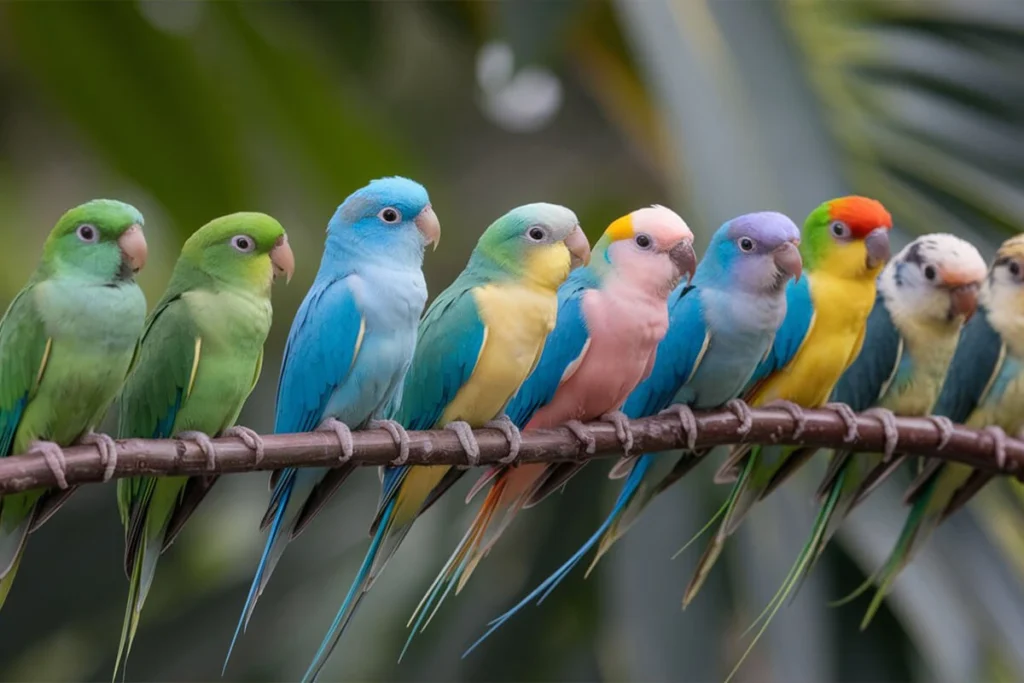
Each of these parrotlet types has its own personality, making them unique additions to the world of small pet birds.
Parrotlet Colors and Mutations
Natural Colors of Wild Parrotlets
Wild parrotlets display primarily green plumage, which helps them blend into their natural habitats in Central and South America. This green coloration provides excellent camouflage in forests, grasslands, and shrublands, keeping them safe from predators.
While green is the dominant color among all parrotlet types, males often have additional blue markings on their wings, rumps, or faces, depending on the species. For example, male Pacific Parrotlets have bright blue streaks behind their eyes and on their wings, while female Pacific Parrotlets lack these markings and remain mostly green. Other species, like the Blue-Winged Parrotlet, have more extensive blue areas, particularly in males.
Wild parrotlets have evolved with these colors to help them survive in the wild. Unlike their selectively bred counterparts in captivity, they do not display the wide range of vibrant hues seen in pet birds.
Common Color Mutations in Pet Parrotlets
Through selective breeding, pet parrotlets now come in a variety of stunning colors beyond their natural green. Some of the most popular color mutations include:
- Blue – One of the most common mutations, resulting in a soft sky-blue or deep cobalt hue.
- Turquoise – A mix of green and blue, giving the bird a unique teal appearance.
- Yellow (Lutino) – A bright, sunny yellow mutation that lacks dark pigments, making the eyes red or pink.
- Albino – A completely white parrotlet with red eyes, resulting from a combination of blue and lutino mutations.
- Fallow – A pale, pastel-colored mutation that can appear in shades of green, blue, or yellow, with lighter eyes.
- Pied – A mix of different colors in a random pattern, often featuring patches of green, blue, or yellow.
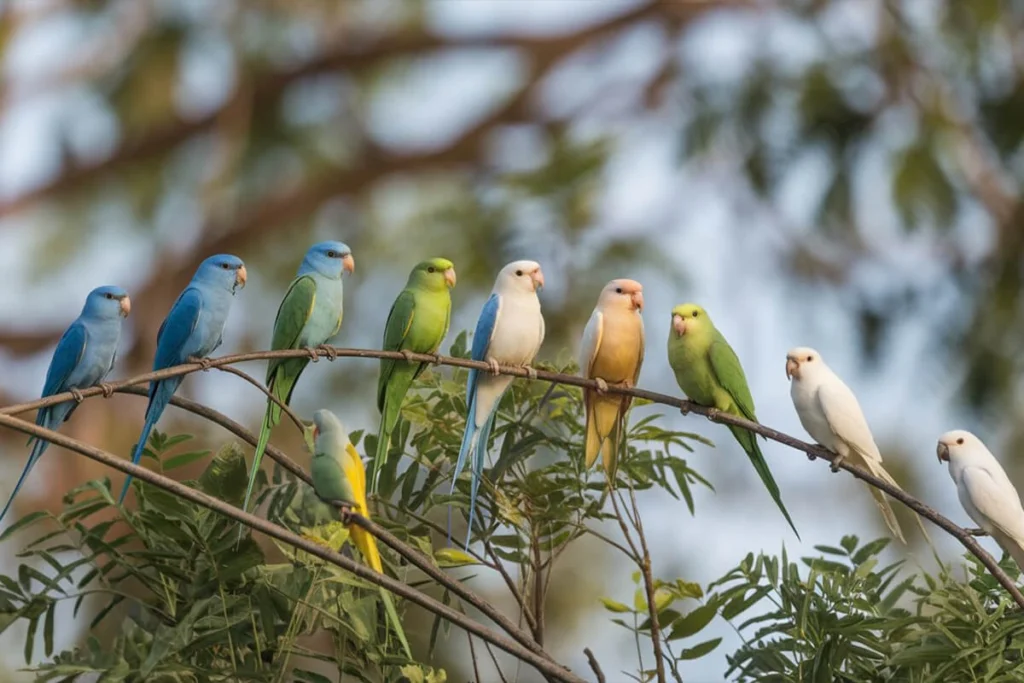
These mutations have made parrotlets even more appealing as pets, offering a variety of choices for bird enthusiasts looking for a unique and colorful companion.
How Selective Breeding Influences Their Appearance
Selective breeding plays a major role in the wide range of parrotlet colors available today. Breeders carefully pair birds with specific genetic traits to create new and more vibrant color variations. Over generations, these selective pairings result in birds with more intense blues, yellows, and other rare colors that do not occur naturally in the wild.
This process also affects a parrotlet’s size and feather quality. Some selectively bred parrotlets may have fluffier or softer feathers, while others may develop slightly larger or smaller body structures. However, selective breeding can sometimes lead to unintended genetic weaknesses, such as reduced immune system strength or vision issues in albino parrotlets.
While wild parrotlets remain predominantly green for survival, the world of pet parrotlets has expanded into a colorful spectrum thanks to careful and responsible breeding practices.
Choosing the Best Parrotlet Breed as a Pet
Factors to Consider
Before bringing home a parrotlet, consider several important factors to ensure a good match between you and your new pet. Parrotlets may be small, but they require daily attention, proper care, and mental stimulation to thrive.
- Personality & Temperament – Some parrotlet types are more independent, while others crave constant interaction. Pacific Parrotlets, for example, are bold and playful, whereas Green-Rumped Parrotlets tend to be gentler and more reserved.
- Space & Environment – Parrotlets need a spacious cage with plenty of perches, toys, and room to explore. They also require supervised time outside their cage for exercise.
- Noise Level – Parrotlets are quieter than larger parrots but can still be chatty. If you prefer a quieter pet, choosing a less vocal individual is important.
- Training & Socialization – Parrotlets need regular handling to stay tame. Without consistent interaction, they can become territorial or nippy.
- Lifespan & Commitment – Parrotlets live 15–20 years with proper care, so adopting one is a long-term responsibility.
Understanding these factors helps you choose the right parrotlet species and ensures a happy, lasting bond with your feathered friend.
Which Species Are Best for Beginners?
Some parrotlet types are better suited for first-time bird owners due to their temperament and ease of care. Here are the best choices for beginners:
- Pacific Parrotlet – The most common and widely available species. They are playful, intelligent, and relatively easy to train but can be assertive if not handled regularly.
- Green-Rumped Parrotlet – A smaller and gentler species, ideal for those who prefer a more relaxed bird. They are less prone to aggression but may be more shy.
- Spectacled Parrotlet – Known for their social nature and ability to bond well with owners. They are interactive but require consistent handling.
Other species, like the Mexican or Blue-Winged Parrotlet, may be harder to find and could be more challenging for beginners due to their independent streaks. Choosing a hand-raised, well-socialized bird is the best way to ensure a smooth experience for new owners.
Differences Between Wild and Captive-Bred Parrotlets
Wild parrotlets and captive-bred parrotlets have distinct differences in behavior, adaptability, and appearance.
- Tameness & Socialization – Captive-bred parrotlets are hand-raised and accustomed to human interaction. They are more social, easier to train, and enjoy companionship. Wild-caught parrotlets, if ever available, are much harder to tame and often remain skittish.
- Diet & Health – Wild parrotlets forage for a varied diet, while captive-bred birds require a balanced mix of pellets, fresh fruits, and vegetables. Birds raised in captivity tend to have more predictable health needs.
- Color & Mutation – Wild parrotlets retain their natural green coloration, while captive-bred parrotlets are selectively bred for different color mutations like blue, yellow, and albino.
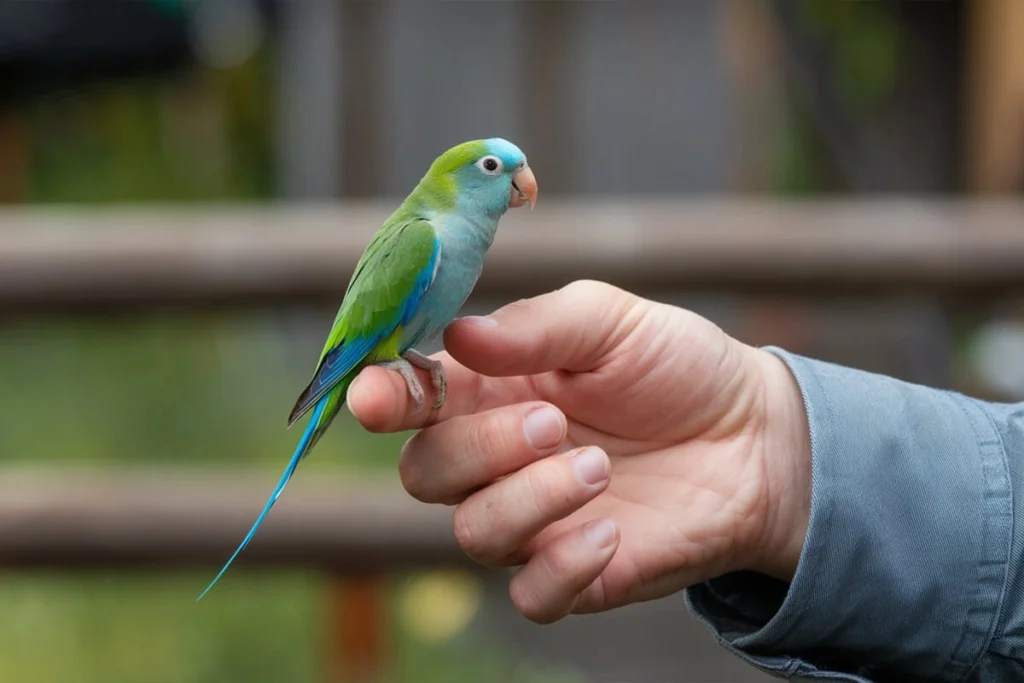
Overall, captive-bred parrotlets are the best choice for pets, as they are already adapted to human companionship and domestic life.
Pet Parrotlet Care and Maintenance
Diet and Nutrition
A well-balanced diet is essential for keeping your parrotlet healthy and full of energy. In the wild, parrotlets eat a variety of seeds, fruits, berries, and vegetation, so replicating this variety in captivity is crucial.
- Pellets – High-quality bird pellets should make up about 60–70% of their diet. They provide balanced nutrition and help prevent deficiencies.
- Fresh Fruits and Vegetables – Offer fresh produce daily, including leafy greens, carrots, bell peppers, apples, and berries. Avoid avocado, chocolate, and onions, as they are toxic to birds.
- Seeds and Nuts – While seeds and nuts are a natural part of their diet, they should only be given as occasional treats due to their high-fat content.
- Calcium and Supplements – Cuttlebones or mineral blocks help maintain strong beaks and bones, especially for breeding females.
- Fresh Water – Change their water daily and ensure they always have access to clean, fresh water.
A varied diet keeps your parrotlet in top condition, preventing obesity and nutritional deficiencies while enhancing their overall well-being.
Housing and Cage Setup
A comfortable and spacious cage is essential for a happy and healthy parrotlet. Even though they are small, they need plenty of space to move, play, and exercise.
- Cage Size – The minimum cage size for a single parrotlet should be 18x18x24 inches, but bigger is always better. If you have multiple parrotlets, opt for a larger enclosure.
- Bar Spacing – The bars should be no wider than ½ inch apart to prevent escape or injury.
- Perches – Provide different-sized perches made of natural wood, rope, or textured materials to promote foot health.
- Toys and Enrichment – Parrotlets love to chew, climb, and play. Offer a variety of toys, including wooden blocks, bells, ladders, and foraging toys. Rotate them regularly to prevent boredom.
- Location – Keep the cage in a quiet yet social area where your parrotlet can interact with family members but is safe from loud noises and direct sunlight.
- Sleep Time – Parrotlets need 10–12 hours of sleep each night. Covering the cage at bedtime or placing it in a dim, quiet room helps them rest.
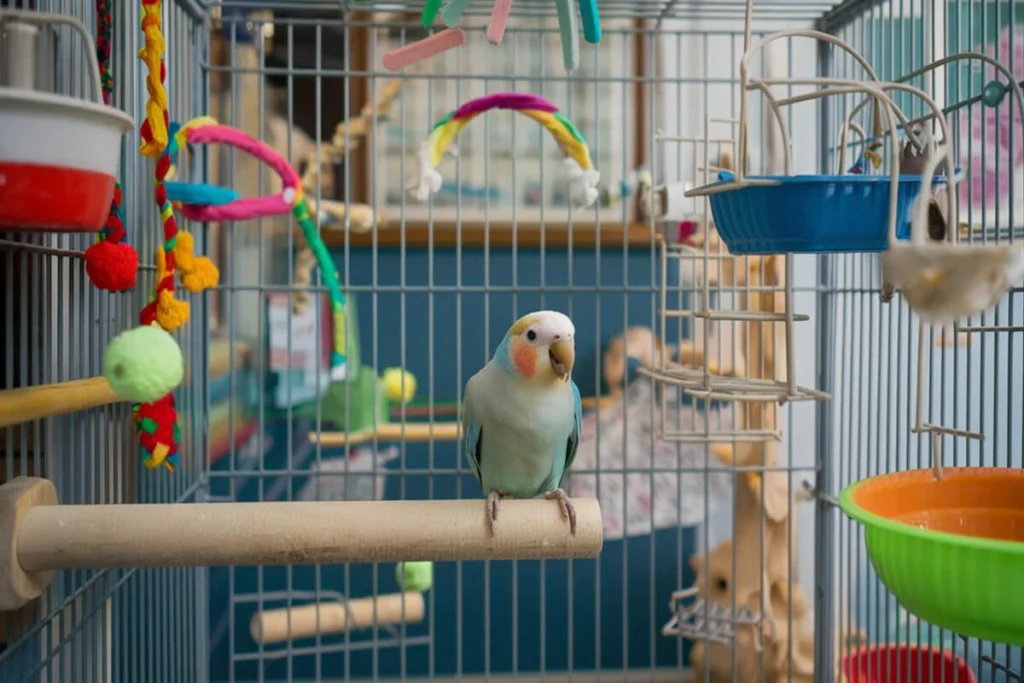
Creating a stimulating and safe environment ensures that your parrotlet stays active, engaged, and comfortable.
Socialization and Training
Parrotlets are intelligent, social birds that thrive on interaction and mental stimulation. Without proper socialization, they can become territorial or develop aggressive tendencies.
- Daily Interaction – Spend at least 30–60 minutes interacting with your parrotlet each day. Talking, playing, and offering treats help build trust.
- Hand-Taming – Start with gentle interactions, allowing your parrotlet to get used to your presence. Gradually introduce your hand, using treats to encourage positive responses.
- Training Simple Commands – Parrotlets can learn basic commands like “step up” (onto your finger) and “step down.” Use repetition and positive reinforcement to reinforce good behavior.
- Avoid Biting Behavior – If your parrotlet bites, avoid reacting aggressively. Instead, redirect their attention with a toy or move your hand away calmly.
- Encouraging Speech and Sounds – While parrotlets aren’t strong talkers, they can mimic whistles and short words with consistent training.
Proper socialization ensures that your parrotlet remains friendly, well-behaved, and bonded to you, making them a delightful companion.
Conclusion
Parrotlets may be tiny, but they have big personalities that make them stand out among pet birds. With their playful nature, intelligence, and affectionate behavior, they quickly become beloved companions for bird enthusiasts. Choosing the right parrotlet type depends on your lifestyle, experience, and preferences. Some parrotlet species, like the Pacific Parrotlet, are bold and energetic, while others, like the Green-Rumped Parrotlet, are gentler and more reserved.
Understanding the different parrotlet types helps you find a bird that matches your personality and care capabilities. Proper diet, spacious housing, and daily interaction ensure a happy and well-adjusted pet. Parrotlets thrive when they receive mental stimulation through training, toys, and socialization. Their strong bonds with owners make them rewarding pets, but they also require patience and commitment.
If you’re a first-time parrotlet owner, choosing a well-socialized, captive-bred bird is the best way to start. Captive-bred parrotlets adapt easily to human companionship and are more comfortable in a home environment. Whether you’re drawn to their vibrant color mutations or their lively and curious personalities, parrotlets bring joy and entertainment to any household.
By providing proper care and attention, you can enjoy a loving and interactive bond with your parrotlet for years. These tiny parrots may be small in size, but they have enormous hearts and an endless capacity to bring happiness to their owners.
Discover the Adorable Mexican Parrotlet Here!
Find Out More about Other Pets and breeds From HERE!
Find Out the Best stuff for your Pet On Pet MD Official
